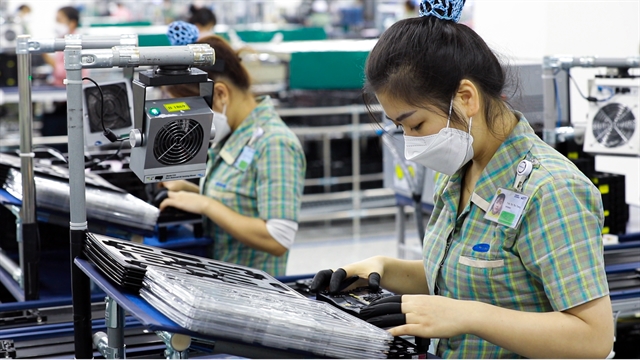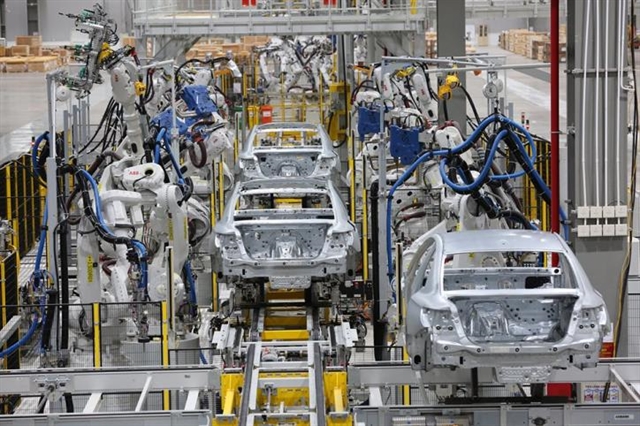 Economy
Economy

As a sector that is crucial to fighting climate change, countries around the world are implementing incentive policies to ‘green’ up the automotive industry.
Ollie Arci and Ly Ly Cao
HÀ NỘI — As a sector that is crucial to fighting climate change, countries around the world are implementing incentive policies to ‘green’ up the automotive industry.
Some of the biggest automakers are catching on to the trend, with the likes of Ford, Audi, BMW and Chevrolet rolling out electric offerings and trying to catch up with the likes of Tesla, which is still in pole position. It seems that electric vehicles (EVs) are here to stay, and with a growing population and rising incomes, Việt Nam is a prime location for the electric revolution to take hold.
According to Bloomberg, by 2030, the global EV market will number more than 90 million vehicles, while vehicle ownership of all types across Southeast Asia is expected to grow more than 40 per cent by 2040. It is projected that by 2025, Ha Noi alone will have 11 million motorcycles on its streets.
Some Southeast Asian nations have already made a head-start in encouraging the use of EVs, with ASEAN spearheading policies to encourage growth.
Bump in the road
Clearly, the COVID-19 pandemic caused significant economic harm, with manufacturing coming to a halt and trade disrupted worldwide. However, as countries start to lift lockdowns and vaccines gain ground, the EV market is sure to pick up some speed again.
One surprising impact of the pandemic is an increase in electric bicycle sales in Europe.

|
| A commuter riding Modmo's bike. — Photo courtesy of Modmo |
Jack O'Sullivan founded electric bicycle company Modmo in 2018. The bicycles are handmade in Viet Nam, which was chosen as a production location for its advanced factories.
“At the moment, 86 per cent of our sales go to Germany. It is much more common to cycle there, during COVID-19, a lot of people were cycling, they stopped using subways or public transportation, and they all bought bicycles. So, we saw a lot of sales in Europe this year,” O’Sullivan said.
New emissions regulations in Europe and China, which came into force between 2020 and 2021, also go some way to explaining why EV-model launches have increased significantly and received an enthusiastic response.
There are, however, some challenges ahead. Associate Professor PhD. Đàm Hoàng Phúc, Deputy-Head of the Department of Automotive Engineering, School of Transportation Engineering at Ha Noi University of Science and Technology, said there are barriers to improving the quality and efficiency of EVs before they become a real alternative to their combustion-engine counterparts.
“In Việt Nam, electric bike and electric motorbike development was booming a few years ago, so every business jumped into this industry and couldn’t control quality, causing the industry to slow down,” Professor Phúc said.
As the industry is the future of transportation, we have seen many start-ups investing in electric motorbikes and other vehicles. Even more advanced tech is making an appearance. At the end of March, Phenikaa Group even introduced Việt Nam's first smart self-driving vehicle.
But still today, you’re more likely to see students riding electric scooters than an electric car.
“The biggest challenge for electric bikes and motorbikes is quality. But electric cars face a bigger challenge. As the production costs of electric cars are more expensive than internal combustion engine vehicles, the industry requires supportive policies.
“The limit on current electric cars is still the distance. To solve this problem there are two ways – one is to improve research to develop a better system and the second is to increase the number of charging stations. This will eliminate the distance limit for electric cars and make it more convenient to charge the battery,” Professor Phúc added.

|
| Inside Vinfast's plant. — VNA/VNS Photo |
This question of policy is important when it comes to regional competition. Although making initial progress with Vinfast – Việt Nam’s own automotive manufacturer which is churning out both electric motorbikes and cars – the country is at risk of being overtaken by neighbours like Indonesia and Thailand.
VinFast’s e34 will be Việt Nam’s first electric car and the company has signed a joint venture with Taiwan’s ProLogium for the production of Solid-State EV Battery Packs. There are also plans to enter the electric vehicle market in the US.
Shifting gears
Considering the relatively high cost of owning and running an electric vehicle in Việt Nam, as well as a current shortage of charging stations, it may be up to smaller start-ups to shift perceptions on EVs. The high number of petrol-powered motorcycles in Việt Nam, and across the region, are prime targets for the shift to electric.
A recent study commissioned by Nissan shows a growing environmental awareness across Southeast Asia, and an enthusiasm for EV adoption. However, the fear of running out of power before arriving at a charging station is the most significant barrier.
The study, by Frost & Sullivan, went on to say: “Over time, increased environmental awareness, lower maintenance costs for an electrified vehicle coupled with tax incentives and improved public and private charging facilities will be key motivators for consumers to possibly switch to electrified vehicles.”
According to McKinsey’s Electric Vehicle Index: “Automakers and suppliers must develop a detailed view of what’s happening in each market by monitoring the regulatory environment, customer preferences, infrastructure development, and the moves of competitors.”
In this way, collaboration between the Government, state-owned enterprises, and the private sector is ultimately vital to building a local EV ecosystem and taking advantage of the powerful trend. — VNS